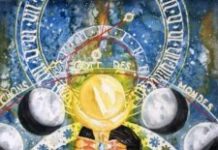
Martin Luther King Jr has become maybe the most recognized humanitarian/activist in modern history. Although his legacy has been one of controversy and mystery, many people today still are unaware of how knowledgeable he was. The following proves that he was aware of the true origins of the Bible. I am not writing this article to diminish the life of MLK. My intent is to help others see that many times we are limited based on the collective consciousness of the majority. In an essay written in 1948 King shows just how far ahead of his peers he was.
“Light on the Old Testament from the Ancient Near East”
With the rise of the science of archaeology many valuable facts have emerged from behind the fog of obscurity into the light of understanding. For years the door of the ancient near east remained locked, and the average mind was content with it being locked; it was content in accepting legendary truth for historical truth. But beginning with the year of 1890 the pendulum of interpretation began swinging in another direction.[Footnote:] According to Wright and Filson scientific archaeology did not commence until 1890. See Wright and Filson. The Westminster Atlas of the Bible, (Philadelphia: Westminster Press, 1942), p. 10. A group of competent scholars came on the scene who were both curious and discontent. They were not willing to accept those things which appeared to be mythological and legendary as historical truths. They dared, in the face of a world of fundamentalists, to apply the scientific method to a study of the old testament. IT was these men who subpoenaed the old testament to appear before the judgment seat of reason. Crozer was a liberal Northern Baptist seminary that for twenty-five years had been carrying on this battle with fundamentalist Northern Baptists entrenched at nearby Eastern Baptist Theological Seminary. At Crozer, scripture itself was “subpoenaed” to “appear before the judgment seat of reason.” Pritchard’s comparative biblical perspective was relative rather than normative. They realized that if they wanted to get an objective standard of reference they would have to go beyond the pages of the old testament into the path that leads to that locked door.
Fortunately, through numerous excavations and assiduous decipherings, that door has been opened. Ever since that time we have been able to get a critical, unbiased, and scientific light upon the old testament. No logical thinker can doubt the fact that these archaeological findings are now indispensable to all concrete study of the Hebrew-Christian religion. These findings have proved to us that there are many striking analogies between the ideas expressed in the Old Testament and those found in surrounding cultures of the near east. For instance the cosmogonic and theogonic views of the old testament are almost identical with those of Babylonian mythology. This is not to say that the Pentateuch writers sat down and copied these views verbatim. The differences of expression attest to that fact. But after being in contact with these surrounding cultures and hearing certain doctrines expressed, it was only natural for some of these views to become a part of their subconscious minds. When they sat down to write they were expressing consciously that which had dwelled in their sub-conscious minds.
The present study represents an attempt to apply the scientific method to an analysis of the old testament in the light of these archaeological findings. The plan of this study involves taking successively five societies and relating their powerful influence upon the Old Testament writers. These societies are Sumer, Babylonia, Egypt, Ras Shamra, and Arabia. This study will not deal with the social and economic structure of these societies as such, but more with their literary compositions.
Before we enter the general discussion one question needs to be answered. Why is knowledge of these societies important for old testament study, specifically Mesopotamia? First, Mesopotamia is the locale for the oldest culture and literature known to man. Its literature reached the height that Greek masterpieces reached. The literature of this culture “furnishes new, rich, and unexpected source material to the archaeologist and anthropologist, to the ethnologist and the student of folklore, to the students of the history of religion and of the history of literature.”[Footnote:] S. N. Kramer, Sumerian Mythology, (Philadelphia: American Philosophical Society), p. viii.
Second, the invention or development of writing was carried out in Mesopotamia. It was this culture that developed the cuneiform system of writing which was later adopted by most of the surrounding cultures.
Third, the study of these cultures of the near east is necessary for a thorough understanding of the Bible. It was the religious and spiritual concepts of these peoples which had a profound influence upon the Hebrews and Greeks. Moreover, by way of the Judaeo-Christian religion, many of these spiritual and religious concepts have been able to creep into the modern civilized world.
Sumer and the Bible
If you look at a map of Mesopotamia you will observe at the lower end the city of Babylon. South of the city of Babylon lies that great city Sumer, from which its grasping fingers captured, in the fourth millennium before Christ, a cultural dominance which tainted the minds of the entire near east. The inhabitants of this area were a non-Semitic, non-Indo-European people. For the moment we will examine the spiritual and religious concepts of these people as revealed in their literature. First, let us look into the myths of origins.
The most significant material for the Sumerian conception of the creation of the universe is to be found in the introductory passage of a poem which was entitled, “Gilgamesh, Enkidu, and the Nether World,” by Dr. Kramer.[Footnote:] Ibid., p. 30 The introductory passage reads as follows:
After heaven had been moved away from earth,
After earth had been separated from heaven
After the name of man had been fixed;After An had carried off heaven,
After Enlil had carried off earth,
After Ereshkigal had been carried off into kur as its prise.After he had set sail, after he had not sail,
After the father for Kur had set sail
After Enki for Kur had set sail;Against the king the small ones it (Kur) hurled,
Against Enki, the large ones it hurled,
Its small ones, stones of the hand,
Its large ones, stones of . . . reeds,
The keel of the boat of Enki,
In battle, like the attacking storm overwhelm;Against Enki, the water at the rear of the boat,
Like a lion strikes down.
If we analyze this passage we will immediately see that many significant questions remain unanswered. Such question as, from whence did heaven and earth come and who separated heaven and earth? Fortunately, DR. Kramer found the answers to these questions in other texts. Thus the cosmogonic concepts of the Sumerians can be summed up as follows: In the beginning, was the primeval sea (Nammu). It is probable that the Sumerians believed that the primeval sea was eternal. The primeval sea begot the cosmic mountain which united heaven (An) and earth (Ki). Heaven (An) and earth (Ki) united giving rise to the air-god Enlil. Enlil, the air-god then separated heaven (An) and earth (Ki).
Now comes the process of organizing the universe. Enlil and Ninlil his wife begot Nammu (the moon-god) who traveled across the sky giving light to the “pitch-dark sky.” Also, the stars and the planets were scattered out. Nammu and Ningal gave rise to Utu the sun-god. Enlil, the air-god, does all of the organizing of earth. He appoints several minor deities to take care of seeds, cattle, etc.
Finally, we come to the creation of man which concludes our study of Sumerian cosmogony and theogony. In short, the creation of man as a result of the combined efforts of the goddess Nammu, the goddess Nimmah, and the god Enki. It is significant to note that these gods fashioned man from clay. Following this creation story, there is a detailed description of the purpose of man being created given in the introduction to the myth “Cattle and Grain.” Actually man was created to relieve the gods from certain work.
WE can readily see that the most obvious similarity between this version and the Biblical version of creation is that of the creation of man. Although they differ as to the purpose for which man was created, they both agree that man was fashioned from clay. Of course, there are many more similarities existing between these versions, but they will be discussed in more detail when we come to the Babylonian documents (which in turn are based upon Sumerian sources).

Cuneiform temple hymn from the nineteenth century BCE; the hymn is addressed to the Lugal Iddin-Dagan of Larsa
The Sumerian deluge story is another interesting myth emerging from Sumerian literature. This story first appears on the fragment of a Sumerian tablet found at Nippur, which is a site north of Shuruppak.[Footnote:] H. V. Hilprecht. The Excavations in Assyria and Babylonia, (1903) pp. 289-568. The poem opens dealing with the creation of men and animals. It goes on to tell how some deity founded five cities: Eridu, Badtibira, Larak, Sippar, and Shuruppak. The poem continues with Ziusudra, the Sumerian Noah, being informed that man would be destroyed. At this time he is appointed to build a large boat in which he would be saved. In the next intelligible part of the poem, we find the flood underway. The next time the text is clear we read how Ziusudra receives eternal life. AT this point it is interesting to note that Ziusudra was the tenth antediluvian king. There may be some correspondence between this tradition of ten antediluvian {kings}, and the Hebrew record of ten patriarchs from Adam to Noah.[Footnote:] George A. Barton. Archaeology and the Bible, 7th ed. (1937) p. 320
This, in short, outlines the ancient Sumerian story of the flood. From this, we can at least see that the Hebrews were not at all original in their deluge story. This deluge story, like the Sumerian creation story, will be discussed in more detail in the next phase of our study.
Babylonia and the Bible
If you will look at your map again, you will notice in the lower valley of Mesopotamia an area known as Babylonia. This area lies some fifty-five miles south of the present Baghdad. For the moment let us turn to the religious and spiritual concepts of this nation as presented in its literature.
First consider the Babylonian Epic of creation or Enuma Elish (“when above”).[Footnote:] Alexander Heidel. The Babylonian Genesis, (1943) When George Smith found among the ruins of King Ashurbanipal’s great library at Nineveh an account of this story, he presented certain facts which revolutionized, in a sense, our conception of history. For years the average individual believed that the biblical creation story was an original document. Now there appears on the scene a document which proves conclusively that a creation story of similar content existed in Babylonian mythology, and even beyond that in Sumerian mythology. Let us look into its content.
First, we must admit that “Enuma Elish” is not primarily a creation story. Only two of the seven tablets deal with creation. The story is actually a hymn in honor of the Babylonian god, Marduk. The priests, who were responsible for the epic, were trying to prove that Marduk, in defeating Tiamat, became the chief god of the pantheon. Therefore, Babylon was the supreme city since it was the city of Marduk. In other words, the epic was more political than religious.[Footnote:] Alexander Heidel. The Gilgamesh Epic and Old Testament Parallels, (Chicago: University of Chicago Press, 1946). p. 3 {Ibid., p. 3.} Of course, this study is concerned with the cosmogonic and theogonic views growing out of this epic. Therefore, no further discussion of the object of this epic is necessary.
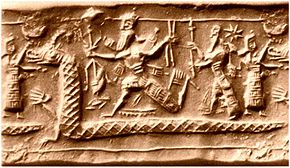
Depiction of Tiamat From The Enuma Elish
The account opens with the birth of the chief gods, Tiamat (goddess of seawater) and Apsu (god of freshwater). They became the mother and father of all the gods. During the course of time, the under gods revolted {against} their parents. Apsu becoming very angry announced his intention of destroying them. The god Ea becomes aware of the plan and ends up slaying Apsu. About this time Marduk, the hero of the epic, is born. At the same time, Tiamat seems to be gathering a host of under-gods whose bodies are filled with poison. Kingu, one of Tiamat’s offspring, is exalted to rule over the entire force of under-gods. At this point, the first tablet closes.
Tiamat was now ready to declare war on the gods who were responsible for Apsu’s death. After learning of Tiamat’s plans the gods became afraid but Marduk volunteered to be their champion. Along with his acceptance as their champion, Marduk requested that he be made the highest god in the pantheon if he killed Tiamat. In tablet three we find the gods in the midst of a banquet discussing the coming war. In tablet four Marduk is found preparing for the war. The epic tells us:
He made a bow and decreed it as his weapon
An arrow he caused to ride thereon and fixed the bow cord;
He lifted up the club and grasped it in his right hand;
The bow and the quiver he hung on his side.
The lightning he set before him;
With a blazing flame he filled his body,
He made a net to enclose Tiamat within it.
Marduk is now fully prepared to enter war. When Marduk comes before Tiamat he says, “come on let us, me and thee, do battle!” The action opens:
Tiamat and Marduk, the wisest of the gods took there stands opposite each other.
They pressed on to the battle, they approached in combat.
The lord spread out his net and enmeshed her,
The evil wind following after, he let loose in her face.
When Tiamat opened her mouth to devour him,
He drove in the evil wind so that she could not close her lips.
As the raging winds filled her belly,
Her belly was distended and she opened her mouth.
He shot off an arrow, it tore her belly,
It cut through her inward parts, it pierced her heart.
When he had subdued her, he destroyed her life;
He cast down her carcass and stood upon it.
After finishing this task Marduk captured the other gods of Tiamat and cast them into prison. Then he returns to Tiamat,
The lord rested, to look at her body to see,
How he might divide the colossus and create wondrous things therein.
He split her open like a mussel into two parts;
Half of her he set in place and formed the sky.
He fixed the bar and posted guards;
He commanded them not to let the water escape.
Now we find Marduk establishing the earth which he called Esharra. Then he places the gods. Anu occupies the skies, Enlil the air, and Ea the waters underneath the earth. This ends at tablet four. The part of tablet five which remains tells how Marduk set up the stars and the moon.
In the next tablet comes the creation of man. Here Marduk slays Kingu, the leader of the gods who caused all of the strife. With the blood that flowed out of his arteries the gods fashioned man. IN creating man the gods were relieved from their work. The epic closes with Marduk becoming the chief god of the pantheon.
Obviously there are many interesting similarities between the creation story presented in Enuma Elish and that presented in Genesis. The most striking similarity between these two accounts is the order of creation. These similarities may be listed as follows: 1. Both accounts agree that a divine spirit created the cosmic matter. 2. Both accounts assume that primeval chaos consisted of a mass of waters. In both cases, the mass of water has the same name. The Hebrews called it thom (deep); The Babylonians called it Tiamat (deep).[Footnote:] Barton, op. cit., p. 295 3. In both accounts, the fifth event of creation is the creation of dry land. 4. In both accounts, the creation of the sun, moon, and stars is the sixth event. 5. In both accounts, the creation of man was the seventh event. 6. In both cases, the divine spirit (or divine spirits) rested on the day after man was created. From this, we can see that the Genesis version and the Babylonian version of creation are well-nigh identical. The important difference lies in the fact that the former is monotheistic and the latter polytheistic.
At this point, we may present the comparison between the Hebrew, the Babylonian, and the Sumerian stories dealing with the creation of man. According to the Bible, man was made from clay. The purpose of his creation was to have dominion over all other animals. In the Babylonian story, man was made of the blood of one of the troublesome gods who was killed for that purpose. He was created primarily to serve the gods and free them from the need of working for their bread. The Sumerian version, which is older than either version, says that man was made from clay as in the biblical version. The purpose for which he was created was to free the gods from laboring for their sustenance, as in the Babylonian version. So much for Enuma Elish.
Another Babylonian myth which has given a new light upon the Old Testament is the Gilgamesh Epic. This epic is truly one of the great literary masterpieces of all times. It compares favorably with Homer’s Odyssey and other great epics of world history. The part of the epic which interests us most in this study begins with the death of Enkidu, the great friend of Gilgamesh. Gilgamesh ie found lamenting:
My friend whom I love has become
like clay, Enkidu whom I love has become like clay.
Shall I not sleep like him?
Shall I rise through all eternity?
His sole interest now lies in finding a method to attain eternal life. He now thinks of Utnapishtim, the Babylonian Noah or the Sumerian Ziusudra, who had received immortal life. We find him undertaking this hazardous journey. As he continues his journey he is told by Ishtar,
O Gilgamesh, whither runnest thou?
The life thou seekest thou shalt not find.
When the gods created mankind,
They alloted death to mankind,
But life they retained in their keeping.
Thou, O Gilgamesh, let thou belly be full;
Day and night be thou merry;
Make every day a day of rejoicing
Day and night do thou dance and play,
Let thou raiment be clean,
Thy head be washed, and thyself be bathed in water.
Cherish the little one holding thy hand,
And let the wife rejoice in thy bosom.
This is the lot of mankind![Footnote:] Alexander Heidel. The Gilgamesh Epic and Old Testament Parallels, (Chicago: University of Chicago Press, 1946). p. 38
It is significant to note that this passage seems to have a close nexus with Ecclesiastes (9:7-9). The ideas of these two passages are well-nigh identical. Well anyway, Gilgamesh continues his long and arduous journey. At last, he reaches Utnapishtim. The question of immortality arises, in which Gilgamesh asks Utnapishtim how he entered company with the gods and obtained everlasting life. Utanapishtim begins:
Shuruppak there is, a city which thou knowest,
Which on the bank of the Euphrates was founded.
That city was old and the gods in it
Were moved in their hearts to send the deluge, they the great gods.
The story continues telling how the gods reveal their plans to Utnapishtim through the wall of a reed hut. After taking these instructions he builds a huge ark which is 120 cubits or nearly 200 feet on each side. On the boat, he loads all the silver and goal and embarks with his family and relatives. The flood came. The climax of the deluge is pictured:
Six days and six nights
Ranged the wind, the deluge, the hurricane devastated the land,
When the seventh day arrived, the hurricane, the deluge, the shock of battle was broken
Which had smitten like an army.
The sea became calm, the cyclone died away, the deluge ceased.
I looked upon the sea and the sound of voices ended.
And all mankind had turned to clay.
Like a roof the hedged park was levelled.
I opened a window and a light fell on my cheek.
I kneeled and sat down to weep,
Tears streaming on my cheeks.
I looked on the quarters of the billowing sea.
A region stood out at a distance of twelve double hour marches.
The boat touched upon Mount Nisir.
Mount Nisir held it fast and allowed it not to move.
On the seventh day Utnapishtim sent forth a dove which returned because it could find no resting place. Following this Utnapishtim is found offering a sacrifice to the gods. Finally, Utnapishtim is pictured kneeling before Enlil receiving these words:
Formerly Utnapishtim was a man
But now Utnapishtim and his wife shall be like the gods.
Utnapishtim shall dwell far away at the mouth of the rivers.[Footnote:] S. H. Langdon. Semitic Mythology, (Boston: Marshall Jones Press, 1941). pp. 210-223.
The above account of the deluge so closely resembles the biblical account (Genesis 6:9 to 9:17) that it hardly needs an explanation, but for the sake of accuracy let me briefly list the similarities. 1. In both accounts, there is a desire within the divine powers to destroy mankind. 2. In both accounts, the secret is revealed to a hero. 3. In both accounts, a vessel is built and the family of the hero is taken in. 4. In both accounts, all mankind is destroyed. 5. In both accounts, a bird is sent out immediately after the flood. 6. In both accounts, the ark rests on a mountain. 7. In both accounts, the hero makes sacrifices to the divine power (or divine powers).
Looking at the flood story from an objective angle we obviously see that the Hebrews have done nothing but taken a polytheistic picture and placed it in a monotheistic frame, thereby producing from Babylonian mythology an almost verbatim story.
We turn now to the code of Hammurabi which is one of the most important monuments in the history of the human race. Containing as it does the laws which were enacted by a king of Babylonia in the Third Millenium B.C., whose rule extended over the whole of Mesopotamia from the mouths of the rivers Tigris and Euphrates to the Mediterranean coast, we must regard it with interest. The code is significant for the present study because many of the laws of the Bible were taken directly from it.
The code included nearly 300 paragraphs of legal provisions touching all phases of life. Let us discuss briefly the important provisions of this code. We immediately see that false accusation is grounds for death (#3). Kidnaping and house-breaking were punishable by death (#6, 14, 21). In the case of stealing at a fire, the thief was to be thrown into the fire (#25). There were numerous laws dealing with the duties of soldiers and tax collectors (#26-41). Marriage was legal only when there was a legal contract, of course, divorces were permissible (#128-143). In the case of adultery, both man and woman would be killed (#129). A married woman was permitted to hold property (#150). If a man caused the death of another man’s daughter his own daughter was to be put to death. Also if a patient died on the operating table the doctor’s hand could be cut off (#215-222). Many other things were covered in the code which will not be mentioned here.
Now let us notice some of the similarities between this code and the later Hebrew laws. With the above laws from Hammurabi’s code can be compared the following Hebrew laws: A false witness was to be visited with the penalty which he purposed to bring upon his brother (Deut. 19:18, 19). The stealing and selling of a man was a capital offense (Exodus 22:2). Breaking in a house meant death (Exodus 21:16). In the case of adultery, both the man and the other man’s wife were put to death (Deuteronomy 22:22). This law is identical to that found in Hammurabi’s code. Deuteronomy (19:21) states exactly the same principle of retaliation as found in Hammurabi’s code, “eye for an eye” and a tooth for a tooth.”[Footnote:] C. H. W. Johns. The Oldest Code of Laws in the World, (Edinburgh: T. & T. Clark, 1903)
The differences between these two systems of law exist because the Hebrews did not have highly organized courts as did the Babylonians. Moreover, the social communities were different. For instance the institution of slavery was not as firmly established in Israel as it was in Babylonia. The Hebrews had to take these laws and fit them into the framework of their social order. From this, we are almost led to believe that if there had been no differences in the two social orders the two systems of law would have been identical. Of course, Barton would disagree with this opinion, arguing that these similarities did not come about because of direct borrowing, but because of similar intellectual outlooks.[Footnote:] Barton, op. cit., p. 406
If we delve further into Babylonian literature we will find a myth entitled, Adapa, which is strikingly similar to the Biblical story of the fall of man. This story “seems intended to explain the mortality of man as opposed to the immortality of the gods.”[Footnote:] Hastings, Encyclopaedia of Religion and Ethics, Vol. II (1910) p. 314. The story opens explaining the qualities and functions of Adapa, the son of Ea. He was a semi-divine being and a priest of the temple of Ea at Eridu. It was his duty to provide the ritual bread and water for this temple. IN carrying out this duty he did quite a bit of fishing. One day while fishing the south wind blew and overturned his boat. Becoming angry because of this event he broke the “wings of the south wind.” At this point, Anu calls Adape to account for this misdeed. Adapa’ father immediately warns him what is about to happen and tells him how to gain the pity of Tammuz and Gishzida. He also tells him not to eat the food nor take the drink that would be offered him for it would be the food and drink of death. Of course, Ea was wrong, rather the food and water offered to him were the food and water of life. Therefore, by rejecting it he was deprived of eternal life.
We immediately see that this myth coincides with (Genesis 2 and 3). Let us list the points of comparison: 1. The “food of life” in Adape belongs to the same category as the “tree of life” in Genesis. 2. Both Adapa and Adam had gained knowledge. In both the knowledge was a power which was an attribute of divinity. This knowledge caused Adape to break the wing of the south wind; it tempted Adam and Eve “to become like God, knowing good and evil” (Genesis 3:5). 3. Both were punished for what they did. Adapa was subjected to sickness, disease, and restlessness. Adam was subject to the monotony of toil and his wife, Eve, to the pangs of childbirth. 4. Both were clothed in a special type of clothing as a consequence of their deeds.[Footnote:] Barton, op. cit. pp. 311-12. This, in short, concludes our study of Babylonia. Now we turn to another great culture of the ancient near east.
Egypt and the Old Testament
We now turn to ancient Egypt which was another great center of civilization that left its mark upon the Old Testament. We know that the Hebrews remained in Egypt for about four hundred years. It is certainly obvious that they assimilated some of the Egyptian cultures during their sojourn there. IN order to get to the roots of Egyptian culture we must dig into its literature. Thus, we will follow this course.
The first phase of Egyptian literature that we will consider here is the composing of proverbs. I think I can be safe in saying that the composing of proverbs were begun in Egypt. One of the first and, to many, the greatest proverb writers to appear on the Egyptian scene was Ptahhotep, who was a grand vizier under a Pharaoh of the fifth dynasty (ca. 2675 B.C. According it other calculations about 2870 B.C.). We find him saying to his son, “Be not arrogant because of thy knowledge and have no confidence in that thou art a learned man. Take counsel with the ignorant as with the wise; for the limits of art cannot be reached, and no artist fully possesseth his skill. A good discourse is more hidden than the precious greenstone, and yet it is found with slave girl over the mile-stone.” He warns his son that “covetousness is a malady, diseaseful, incurable.” He makes it very clear that “he who hath heard becomes a hearer.”[Footnote:] Adolf Erman. The Literature of the Ancient Egyptians (1927) pp. 54-65 Throughout the teachings of Ptahhotep we see many proverbs which are strikingly similar to those found in the Biblical book of Proverbs. It was the greatness of Ptahhotep’s proverbs that led Breasted to say, “these maxims of Ptahhotep constitute the earliest formulation of right conduct to be found in any literature.”[Footnote:] J. W. Breasted. The {Dawn} of Conscience, (New York: C. Scribner’s sons, 1933). p. 129
Another important figure who contributed greatly to Egyptian literature was Amenemope. Like Ptahhotep, he offered sound advice to his son on honesty, integrity, self control and kindness. It was essentially this profound advice that proved to be of lasting influence to the Hebrews. We find striking parallels of Amenemope in Jeremiah, Psalms, and Proverbs. Here is one parallel:
| Amenemope | Proverbs (15:16f.) |
| Better is poverty in the hand of God, Than riches in the storehouse. Better are loaves when the heart is joyous, Than riches in unhappiness. | Better is little, with the fear of Jehovah, Than great treasure and trouble therewith. Better is a dinner of herbs, where love is, Than a stalled ox and hatred therewith. [Footnote:] Breasted, op. cit., pp. 372-378. |
This is only one instance of many where there is a direct similarity between the wisdom of Amenemope and Biblical versions.
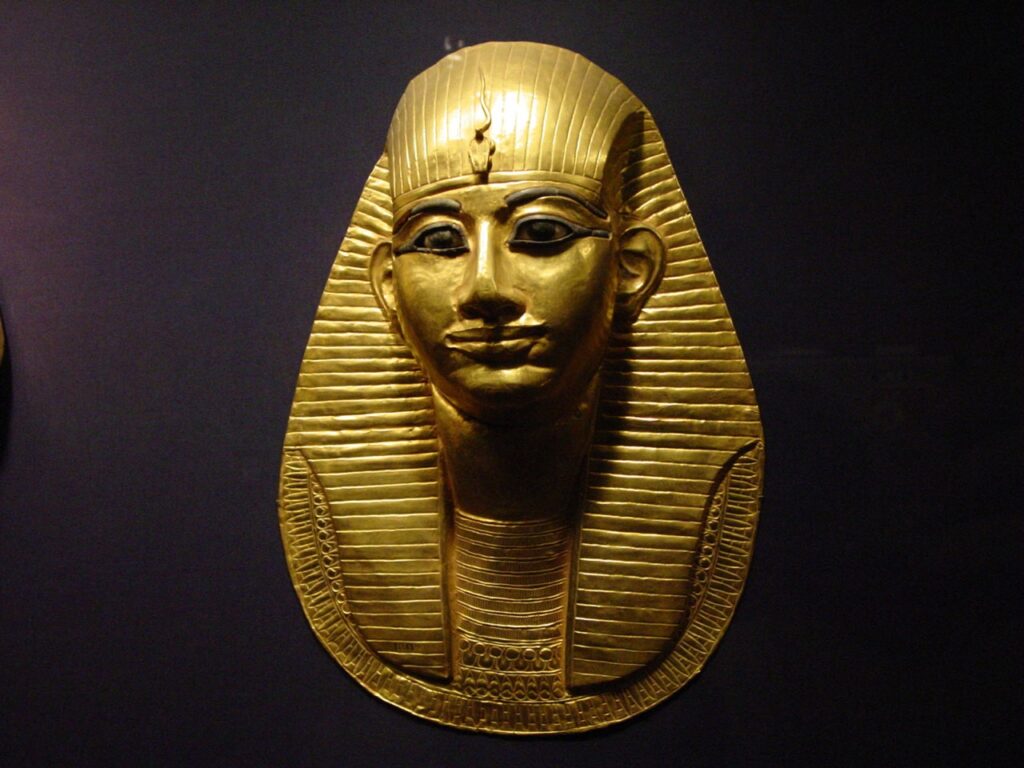
The Mask of Amenemope
Before we close our study of Egypt and its relationship to Old Testament literature, we must consider Amenhotep IV (Akhnaton). This interesting character was a king of the eighteenth dynasty (ca 1570-1150 B.C.), who through many lofty ideals became “the first individual of history.”[Footnote:] J. H. Breasted. A History of Egypt, (New York: C. Scribner’s sons, 1905). p. 265. His greatest contribution to Egyptian culture was his new idea of God. He introduced solar monotheism at a time when his nation was steeped in the tradition of polytheism. Unfortunately, his monotheism died with him.
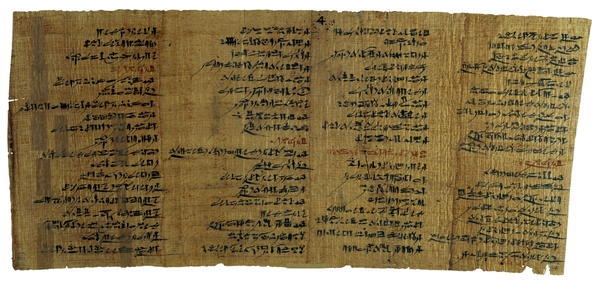
The Instruction of Amenemope AKA The Proverbs of Amenemope
Either for the temple service or for personal devotions the king composed two hymns to Aton, which are quite relevant for our present study. The one-hundred-and-fourth Psalms of the Hebrews shows a notable similarity to this hymn both in thought and sequence. Some very interesting phrases which appear in Akhnaton and the Bible are: “The earth is in darkness like death” (cf. Psalm 104:20); “all serpents they sting” (cf. Psalm 104:21); “thou didst create the earth according to thy heart” (cf. Psalm 104;24). From these few examples, we are {able} to see the tremendous amount of influence that this hymn had on the Biblical writers. With these explanations, we now leave Egypt.
Ugarit and the Old Testament
In 1929 some very important tablets were discovered at a site on the northern coast of Syria known as Ras Shamra. The discovery of these tablets was one of the most important discoveries made in the near east. They afford us valuable evidence as to the nature of religion in Syria and Palestine several centuries before the Israelite monarchy, and also constitute a new revelation for the study of the Old Testament.

Ugarit Alphabet
This spot (Ras es Shamra) was known in its earlier history as Ugarit. The town seems to have been in existence well before 2000 B.C., but it didn’t rise to importance until the second Millenium when the Phoenicians took possession of it.
The language spoken by the Ugaritic people was Senetic. It was very closely connected to Hebrew. For this reason, Hebrew and Ugaritic poetry are very similar.
Although the religious ideas of the Bible are quite different from those found in Ugarit, the former being monotheistic and the latter being polytheistic, there are many striking similarities between the two. For instance, more than one Ugarit tablet mentions the serpent Leviathan, and the monster is described in exactly the same terms in (Isaiah 27:1). It is also significant to note that the same two adjectives namely “swift” and “crooked” are applied to the Biblical version.[Footnote:] J. W. Jack. The Ras Shamra tablets and their bearing on the Old Testament, (Edinburgh: T. & T. Clark, 1935). p. 46. The servant of Aleyn is described as “HE who rides upon the clouds” (cf. Isaiah 19:1). The Biblical verse, “I know my redeemer liveth,” can be compared to the Ugarit verse, “I know that Aleyn son of Baal liveth.” In Ugarit appears the phrase, “from generation to generation” (cf. Ex. 17:16, Dt. 22:7, Ps. 10:6, Is. 13:20). The Ugaritic phrase, “the dew of heaven, the fat of earth” is found with little change in Genesis 27:28, 29. The Ugaritic phrase, “eat of the tables spread, drink of the jars wine,” can be compared to Proverbs 9:5, “eat of my bread, and drink of the wine which I have mingled.” At Ugarit wine was called “blood of vines;” in Genesis 49;11, it is called the “blood of grapes.”[Footnote:] Cyrus Gordon. The loves and wars of Baal and Anat, (Princeton: Princeton University Press, 1943). p. 8 Other phrases which appear both in Ugaric and the Bible are: “The mount of God” (1 Kings 19:8); “the river of God” (Psalms 46:4); “house of cedar” (2 Samuel 7:2).
Many more similar phrases exist, but these are sufficient to show the intimate relationship between these Syrian tablets and the literature of the Old Testament.
Arabia and the Old Testament
We come now to the last phase of this study. This phase deals with another area of the ancient near east which had a profound influence on the Bible namely, Arabia. A basic core of belief and institutional life came out of this desert. According to Montgomery, “the central nerve of Hebrew religion leads back to Arabia.”[Footnote:] James Montgomery. Arabia and the Bible, (Philadelphia: University of Penn. Press, 1934). p. 15. A peculiar touch and atmosphere of Biblical life came from the free moving nomadic life we call Arabia.
Throughout the Old Testament, we are aware of Arabian influence. “The legendary account of the garden of Eden presupposes the scenery of a desert oasis, with its rivers springing up miraculously from nowhere and emptying into the desert sands.”[Footnote:] Montgomery, op. cit., p. 3 In (Genesis 4) we have three classes that appear throughout Arabian history: Jabal, the father of flock keepers; Jubal, the father of minstrels and Tubalcain. Tamechs’ taunt song (Genesis 4:23-24) is our earliest example of the Arabian satire. The Israelite journey to the land of Egypt during the time of the economic crisis is also typical of Arabian nomads. In the prophetic literature of the Bible, the prophets often refer to the nomadic life of their people as a time of pure worship. In the words of Wright and Filson, “the close relation of God and people, as symbolized in the covenant, was Israel’s nomadic heritage, and the most important factor saving her from idolatry. These basic elements of patriarchal religious life were idealized in la later Israel and always remained as a purifying agent, not only among such extremists as the Nazirites and Rechabites, but among the great prophets as well.”[Footnote:] Filson and Wright, op. cit. p. 5.
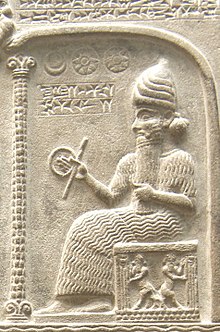
The Sumerian Sun Deity Utu
There are many characters in the Bible who are full of Arabian characteristics. For instance Jephthal is more of an Arab than an Israelite. His sacrifice of his daughter is parallel to the Arabian tradition. Deborah is a typical Arab in Judges 4 and 5.
From these parallels, we obviously see that Arabia had a profound influence on the Old Testament. This is not to say that we can explain away Israel’s unique conception of God simple by reference to the Arabian Desert, but the contention is that the ideal background of Hebrew religion lay in the desert, not in the scenes of urban civilization, and to that background, the prophets constantly appealed.
Conclusion
What now is the conclusion of the whole matter. First, we must conclude that the Old Testament has its roots not only in the history of the Hebrew people. Instead, one must consider the Old Testament in relation to all the ancient civilizations of the near east. Modern archaeology has proven to us that many of the ideas of the Old Testament have their roots in the ideas of surrounding cultures. Many would argue that these archaeological findings have proven to be very pernicious to modern religion. They argue that archaeologists have robbed the Old Testament of any claim to uniqueness. Of course, any logical thinker must believe the contrary. From attempting to destroy the usefulness of the Old Testament, an archaeologist is attempting to give a better understanding of the contents of the Bible. They realize that religion, as for as possible, must be scientifically tenable. It is my opinion that “Biblical criticism” and “Biblical archaeology” will serve to justify the position of the church in modern culture, especially in the face of modern youth who are taught to “weigh and consider.”
Second, we must conclude that many of the things which we have accepted as true historical happenings are merely mythological. They are merely modified links connected to the wide chain of mythology. Again this conclusion will shock many. But why so? One needs only know that a myth serves the purpose of getting over an idea that is in the mind of the author. Therefore, it becomes just as valuable as factual. Dr. Bevan succinctly stated it: “We have documents which record actual historical events with the names of persons who lived and acted more or less in the way described; then, as we follow back the story, we find ourselves in a past with which the real history is apparently continuous, but which is in truth only only a work of imagination, a mythical past set behind [strikeout illegible] the historical events and and concealing the real past out of which in actual fact the historical process came.”[Footnote:] S. H. Hooke. In the Beginning, (Oxford: Clarendon Press, 1947). p. 149. If we accept the Old Testament as being “true” we will find it full of errors, contradictions, and obvious impossibilities–as that the Pentateuch was written by Moses. But if we accept it as “truth” we will find it to be one of the most logical vehicles of mankind’s deepest devotional thoughts and aspirations, couched in language which still retains its original vigor and its moral intensity. This conclusion is an apologia for critical Biblical scholarship, both as a way of vindicating the church and religion in modern culture and as a way of distinguishing the transient “mythological” from the permanent “logical” truth in the Western religious tradition.
My books on Amazon
https://www.amazon.com/s?k=dewayne+hendrix&ref=nb_sb_noss

https://www.facebook.com/SupremeScience99/
Citations
https://kinginstitute.stanford.edu/king-papers/about-papers-project










